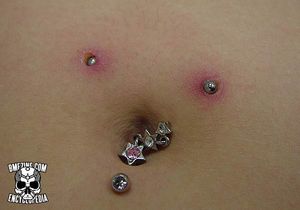Short Surface Bar
Surface bars are absolutely not one-size-fits-all. Not only do they have to be the right length, but the "legs" (the part that sticks up through the skin) have to be the right height. If the legs are too short, the balls will be pulled down, and the pressure will be applied upwards as well, inciting rejection.
One of the reasons that you need an experienced piercer for doing this type of work is that different parts of the body not only have different skin thicknesses (which determines how long the legs will need to be) but also different ways of healing — if the body part is going to swell a lot during healing, longer posts will be needed. If the piercer doesn't understand these issues, they may accidentally use jewelry that will hinder your healing.
If this type of problem happens to you, don't let it progress as far as the picture — if you notice that the balls on your surface bar are dimpling down into the skin, then you should go to your piercer ASAP and see what they have to say. A surface piercing is a difficult thing to save when things go wrong though, so try not to make this mistake at all.
Note: Having the legs on a surface bar too long isn't a good thing either, because it will mean that the entrance/exit points will take far more abuse.
